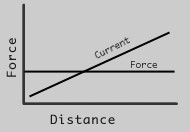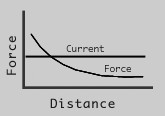|
Application
Information For Solenoids
Application/Use
Solenoids are used in
applications where a short linear force is needed to
push or pull. Rotary solenoids are also available
where a short rotary force is required. Runton
Engineering current manufactures only linear action
solenoids.
Stroke
Stroke length is generally
limited to less than 0.4 times the outside diameter
of the solenoid. Unlike air and hydraulic pistons a
solenoid force is generated by magnetic line of
force between the plunger and the fixed plunger
seat. As the stroke is increased the force lines
become weaker thus good solenoid applications fall
into a relatively short stroke area. Information
relating to the stroke and force can be found on the
individual Data Sheets.
Force
The force produced by a
solenoid is proportional to its ampere turns
produced by its coil and the efficiency of its
magnetic circuit. AC solenoids characteristically
have a flat force curve with a dropping current
flow.

The reason for this is that
as the laminated pole pieces close, the inductance
increases causing the "back EMF" to limit the
current flow. The initial current is limited mostly
by the DC resistance of the coil. The final current
is limited by the full closed inductance of the
device as well as the coil resistance.
DC solenoids have a steady
current flow for any fixed voltage and at a given
temperature. The current is limited by the DC coil
resistance. This produces a rising force as the pole
pieces close in distance.

More force can be generated
with DC solenoids by "over-driving" the coil
initially and then reducing the current flow to a
holding current after the plunger has done its work.
Runton Engineering has available power controllers
for this purpose. Or, if the solenoid needs to
operate for a short time, it can simply be supplied
with an increased amount of power for a short
operating cycle.
Push, Pull, and Push-Pull Solenoids
Most solenoids shown by the
Data Sheets show push type solenoids. Pull type
solenoids can be made by having the shaft emerge
from the reverse end of a push type solenoid.
A push-pull type solenoid
requires two coils, one for each motion. It is
constructed with one case, but with two coils having
essentially the same electrical and physical
characteristics as a push type solenoid. Select a
push type solenoid and specify Push-Pull.
Coil Resistance
The resistance of a copper
wound coil changes as it heats up. The change is at
a rate of 0.00393 times the resistance per degree
Centigrade. The formula is:
R
=
Ro (1+sT)
where
R
is the resistance of the coil
in ohms at operating temperature,
Ro
is the room temperature resistance of the coil in
ohms, s=0.00393,
and T
is degrees Centigrade.
As resistance increases the
current falls for a given voltage thus the ampere
turns decrease causing the force output to decrease.
Allowances must be made for the heating of the coil
by establishing the potential maximum running
temperature and being certain to provide sufficient
voltage. It is then necessary to select a coil
resistance for the solenoid which will produce the
desired force output under all conditions.
Additional Options
- Return Springs - Return
springs are often added internally to return the
shaft to the non-energized position.
- Shaft Modifications -
The shaft connects to the load and it is often
necessary to modify it with slots, thread,
holes, pads, different lengths or other
configurations in order for the shaft to do its
job. It is usually less expensive to do this
while the solenoid is at the assembly stage.
- Mounting Variation -
Every solenoid design is shown with a standard
mounting. A customer's application often
requires a modification of some sort in order
for the solenoid to fit into the application
properly.
- Electrical Connection -
An electrical connection is a necessity. To fit
the application different grades of lead wire,
different lengths and termination types can be
supplied.
- Seals - Solenoids can
be made waterproof in various ways depending on
the application and the solenoid type. Also
solenoids can be sealed so that it can be used
in a "wetted" application. This is where the
plunger and possibly the coil become immersed in
a fluid associated with its purpose such as
valve application.
- Explosion-Proof Designs
- Runton Engineering manufactures
explosion-proof solenoids such as the ones shown
on Data Sheet 10. For this type of solenoids
there are size limitations because of the
necessity of having a "flame path" length built
into any opening into the solenoid interior.
This produces solenoids which are fairly large.
- Position Indicators -
Internal position can be installed to provide an
indication of the plunger position, either
energized or non-energized.
|



